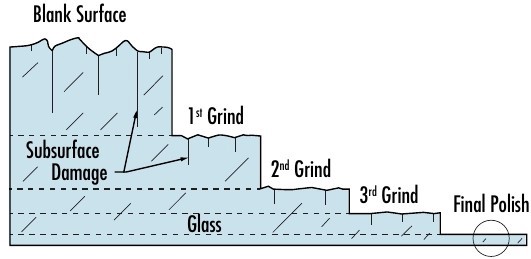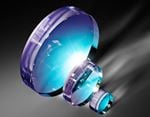次表面損傷
雷射資源指南第8.7部份。
每種光學元件在製造時不論多細心,都會在光學元件頂層表面下方出現某種程度的次表面損傷,例如裂縫、殘餘應力、污染及空隙1。前述瑕疵可能是在製程期間造成,或因為使用材料的類型或品質造成。以雷射照明時,次表面損傷可能增加吸收及散射,產生熱能進而降低光通量。使用高功率雷射時,或是系統承受大量機械應力時,以上效能不規則度可能造成系統失效。
研磨及拋光製程會在拋光再沈積層或比耳拜 (Beilby) 層下方,留下約0.1μm 至數十微米的次表面損傷。再沈積層是光學元件頂層,在拋光期間因為化學反應重新流過精細表面刮痕2。每個研磨及拋光步驟都會尋求移除足夠材料,達到先前步驟最深處的次表面損傷,以減少當前步驟預期造成的損傷深度,讓每個後續步驟移除的材料越來越少 (圖 1)。

圖 1:製程留下的次表面損傷量,在每個研磨及拋光步驟之後減少3
除非採用特殊的雷射級拋光及清潔製程,否則拋光期間可能有雜質進入再沈積層。以更細的顆粒拋光,可進一步減少次表面損傷,但無法將其完全移除。以更細的顆粒拋光可提升光學元件品質,但是會增加拋光所需時間,進而增加成本。有效的雷射光學元件拋光製程,可確保移除深度次表面損傷,而效果不彰的製程只能將損傷隱藏在比耳拜層下方。
參考資料
- Fine, Kevin R, et al. “OPTICS FABRICATION: Subsurface Damage Is Measured Nondestructively.” Laser Focus World, June 2006.
- Finch, G. Ingle. “The Beilby Layer on Non-Metals.” Nature, vol. 138, no. 3502, 1936, pp. 1010–1010., doi:10.1038/1381010a0.
- Suratwala, Tayyab. “Glass Finishing (Grinding and Polishing).” Lehigh University Glass Processing Course, March 2015.













 上個章節
上個章節 



or view regional numbers
QUOTE TOOL
enter stock numbers to begin
Copyright 2023, Edmund Optics Inc., 14F., No.83, Sec. 4, Wenxin Road, Beitun District , Taichung City 406, Taiwan (R.O.C.)
California Consumer Privacy Act (CCPA): Do Not Sell My Information